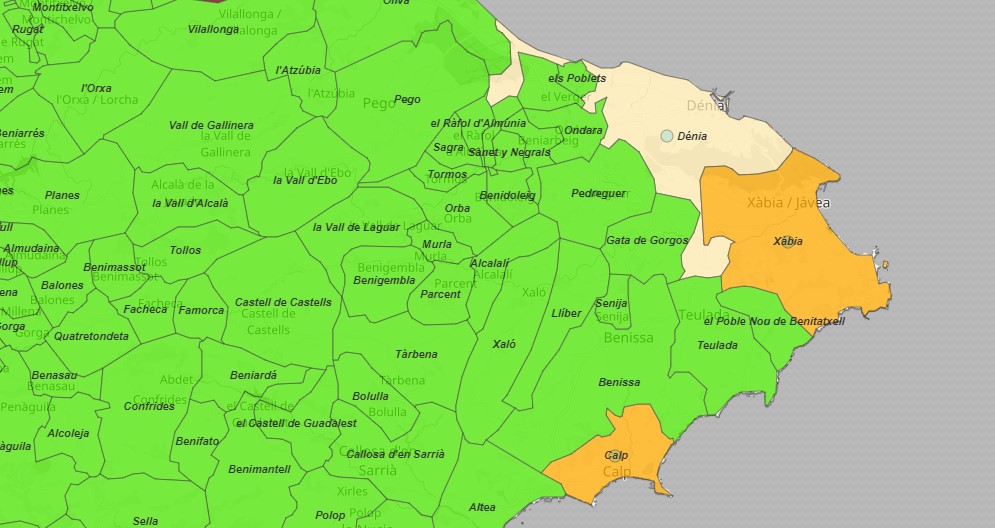VIRUS UPDATE: Xàbia moves up into ‘Medium Risk’ level after 12 positives in a week
The town joins Calp at the ‘Medium Risk’ level and citizens are reminded that the numbers of fully vaccinated people are not yet enough to lower the guard and all necessary ‘non-pharmaceutical’ measures must be maintained.

Tuesday 27th April 2021 – Compiled by Mike Smith
Xàbia has moved back up into the ‘Medium Risk’ level after recording another four positive cases over the weekend, resulting in the 14-day IA rate, a measure of the speed at which the virus moves through the population, rising to 50.72 cases per 100,000 inhabitants, the highest since the end of February.
The health situation in the municipality has changed markedly in a week. Last Tuesday, the statistics showed that Xàbia had not recorded a single positive case since April 7th. But then an outbreak of the virus was recorded last Thursday, of social origin and directly affecting three people, and a total of 12 people have returned a positive test over the past week. Since the pandemic began, 1,454 positive cases have been reported in Xàbia.
Calp is the only other municipality in the Marina Alta region to find itself in the ‘Medium Risk’ category with a 14-day IA rate of 66.01 cases per 100,000 inhabitants, recording another six positive cases over the weekend. Dénia registered five new cases but its 14-day IA rate of 33.20 means that it remains in the ‘Low Risk’ level. The rest of the Marina Alta is coloured green, the ‘New Normal’ level, having not recorded a new positive case over the weekend, with its 14-day IA rate currently 27.37 cases per 100,000 inhabitants.
This rise in cases serves as a very real reminder of the importance of maintaining the long-established health protocols to reduce the risk of the spread of infection and as the regional government have already declared, whilst vaccination is the clear way out of the crisis, the numbers of fully vaccinated people are not yet enough to lower the guard and all necessary ‘non-pharmaceutical’ measures must be maintained. We at javeamigos.com also want to encourage everyone to keep going so that the light at the end of the tunnel gets bigger and brighter each day and each week.
Spain
Spain’s 14-day IA rate is 235.59 cases per 100,000 inhabitants, placing the country in the ‘High Risk’ category. The so-called ‘Fourth Wave’ appears to be flattening with the IA rate fluctuating around the 230-235 mark for the past week, which experts have attributed to the vaccination campaign and the ongoing restrictive measures imposed across most of the country. Easter has passed and there doesn’t seem to be a marked increase in infections, nor are they expected to rise much further as experts continue to analyse why the current wave is not following the pattern of the previous three.
Across the autonomous regions, the País Vasco leads the way with a 14-day IA rate of 527.18, placing it firmly in the highest ‘Extreme Risk’ category along with seven others – Melilla, Madrid, Navarra, Cataluña, Ceuta, La Rioja and Aragón – whilst the Comunidad Valenciana (41.94) remains the only region in the ‘Low Risk’ level and can still boast one of the lowest levels in the Europe.
Vaccination
The vaccination campaign continues as quickly as possible but the health authorities can only administer the doses that they have in their possession and continued distribution issues and pauses in supply of certain vaccines due to safety concerns continue to affect its progress. Spain has currently ordered more than 93.5 million doses, of which it has received 16.5% (15,443,085), the majority of which have been the Pfizer/BioNtech type. As of Monday 26th April, 95.3% of all vaccines received (Pfizer/BioNtech, Moderna, AstraZeneca/Oxford, and Janssen) have been administered nationally.
At the time of writing, 22.8% of the population has received at least one dose, mostly the older age groups which experts agree has contributed to the fall in deaths and hospitalizations; the fourth wave is not applying as much pressure on the hospital system as the previous waves and admissions have not shot up as they did in November and January.
Daniel López-Acuña, a former director of emergencies at the World Health Organization (WHO), said that “it is likely that the magnitude of the wave is not so pronounced because there is less mobility than at Christmas, fewer crowds and a segment of the population is protected [by vaccines]“. But he urges that social responsibility of citizens remains high: “Caution and prudence“.
Links
Actualización nº 361. Enfermedad por el coronavirus (COVID-19). 26.04.2021
GIV COVID-19 Gestíon Integral de la Vacunación 26/04/2021
COVID-19 C. Valenciana: Monitoratge de la situació



